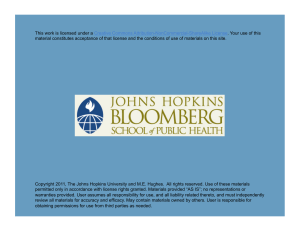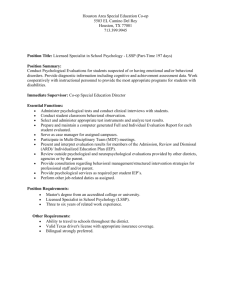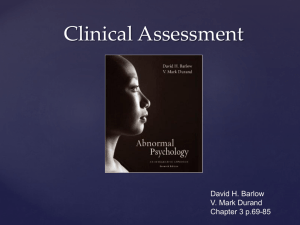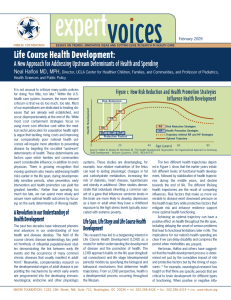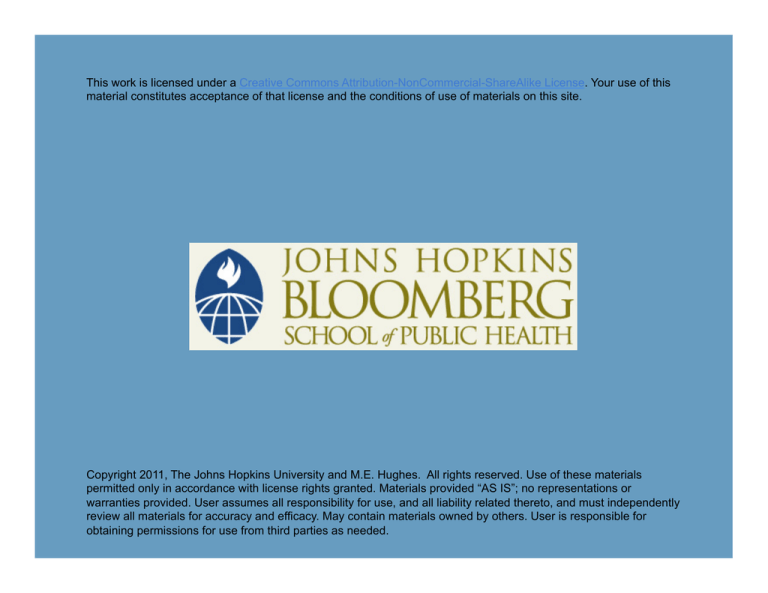
This work is licensed under a Creative Commons Attribution-NonCommercial-ShareAlike License. Your use of this
material constitutes acceptance of that license and the conditions of use of materials on this site.
Copyright 2011, The Johns Hopkins University and M.E. Hughes. All rights reserved. Use of these materials
permitted only in accordance with license rights granted. Materials provided “AS IS”; no representations or
warranties provided. User assumes all responsibility for use, and all liability related thereto, and must independently
review all materials for accuracy and efficacy. May contain materials owned by others. User is responsible for
obtaining permissions for use from third parties as needed.
Section B
Human Development as an Underlying Process
Life Course Perspective Allows for Time
How individual health changes over time
Variation in determinants over the life span
Long-term influences
Accumulation of risk and protective factors
Exposures that affect health only at certain points in life span
3
More Importantly
Implicit processes underlying observed relationships between time
and health
- Key for theory, practice, and policy
Ben Shlomo and Kun, 2002—natural history of biological systems and
disease
Not just interested in departures from the normal—“when things go
wrong”
Many of the outcomes of interest in public health are psychological,
social, or behavioral
4
What Is Development?
Process of intraindividual change over time (over individual’s life
span)
Transformational: change in the form, organization, or structure of
a system
- Increase in complexity results in novelty
- Qualitative change, produces discontinuities
Variational: change leading to deviation from an individual’s
standard, norm, or average
- Builds on existing capacity
- Quantitative change, continuous
5
What Is Developing?
Focus of theory is developmental process
Focus of researcher is specific domain of human structure, function,
capacity, behavior, or experience
Here, more general view of outcomes; consider three broad
domains: biological, psychological, and social
6
Physiological
Biologically based systems inside the body
Tissue differentiation, synaptic pruning, muscle growth, pubertal
development, onset of frailty
Not all change is in positive direction (frailty)
Changes can be non-optimal (tumor growth, high-stress reactivity)
7
Psychological
Inside the brain
Attachment, increases in vocabulary, morality
8
Social
Outside the body and brain
Adoption of social roles, creation of social relationships, attainment
of social positions
Compose the social pathways of interest in life course research
External circumstances important to defining social functions,
capacities, behaviors, and experiences
9
Domains Intertwined
Categorizing a particular function, structure, capacity, behavior, or
experience as biological, psychological, or social is often incorrect
and even impossible
Some development is purely physiological, e.g., early embryonic
development
Becoming a parent entails elements of all three dimensions; so do
the onsets of adolescence and attainment of adulthood
10
Key Features of Development
Plasticity and diversity
Extends across the entire life span
11
A Life Course Perspective
Conceptualizes health as the reflection of an underlying
developmental trajectory
Trajectory is multidimensional
- Biological, psychological, behavioral, and social aspects
What “health” means varies by position on this developmental
trajectory (i.e., by age)
12
A Life Course Perspective
Conceptualizes health as the reflection of an underlying
developmental trajectory
Trajectory is multidimensional
- Biological, psychological, behavioral, and social aspects
What “health” means varies by position on this developmental
trajectory (i.e., by age)
13

